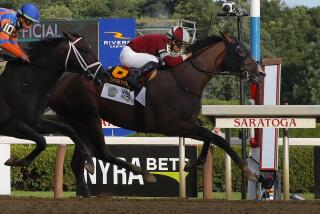Distance is part of the mystique of the Belmont Stakes
Reporting from Elmont, N.Y. — Trainer Bob Baffert was getting impatient Thursday morning waiting for the painfully slow tractors to finish conditioning the track so Justify could start his morning gallop.
Jockey Mike Smith was there to watch exercise rider Humberto Gomez take the colt for his almost 1 1/2-mile jaunt over the Belmont Park racing surface.
“Hey, are you riding in that other [1 1/2-mile] race, the Brooklyn?” Baffert asked Smith, Justify’s regular jockey.
“Nope, I’m not in that race,” Smith said.
“Good, because I’m not sure you have two mile-and-a-half races in you,” Baffert shot back with a laugh.
The obsession with the length of the Belmont Stakes is part of the mystique of this race. It’s probably the only time a horse will run that distance on the dirt. On Belmont Stakes day, the Brooklyn Invitational for older horses also is run over 1 1/2 miles. The Triple Crown races are restricted to 3-year-olds.
Intuitively, the Belmont should be a race that favors horses that run late and pass tiring front-runners. But according to previous race winners, that premise is completely wrong.
“It’s not a speed race necessarily, but horses that come from way back do not do as well,” said Jerry Bailey, a Hall of Fame jockey who also works as a commentator for NBC Sports. Bailey won the Belmont twice.
“The misconception is that deep closers do better because the horses in front tire,” Bailey said. “But in the Belmont, they don’t go that fast early, so they don’t slow down. The early pace is more deliberate, and the lead horse can hold on and win because they don’t slow down.”
It will be Smith’s job to navigate Justify around the track at a smart pace to become the 13th horse to win the Triple Crown. Smith has won the Belmont twice.
“It’s really not that different [a race to run],” Smith said. “I think people tend to think too much. You just need to get your horse in a nice comfortable rhythm and try not to move too soon.”
Victor Espinoza has won the race only once, but that was three years ago aboard Triple Crown-winner American Pharoah. He tends to agree with Smith that the distance makes no difference.
“Sometimes, it can be a little confusing to think about a mile and a half,” Espinoza said. “But my best rides, I ride just like they are a mile and an eighth. The horses run exactly the same as a mile and an eighth.
“You think in the back of your mind that I have to go slow or I can’t wait too long or I have to go easy with him out of the gate. That is why it can get a little confusing for me.”
The greatest Belmont was in 1973 when Secretariat won by 31 lengths to complete the Triple Crown. It was the second Belmont win for Canadian jockey Ron Turcotte. From his perspective, the Belmont is not difficult at all — which is easy to say when you are riding Secretariat.
“I think the Belmont is the easiest of the three [Triple Crown races],” Turcotte said. “Why is that? Because there are many chances to overcome different things. You might get squeezed, you might get shut off, you might stumble at the start. Anything can happen, but you can recover without rushing your horse and make it up real quick.”
Still, riding at Belmont is different from most tracks. For starters, it is a 1 1/2-mile track, compared with Santa Anita or Del Mar, which are one mile. The homestretch at Belmont is 107 feet longer than Santa Anita’s and 178 feet longer than Del Mar’s, meaning all that extra distance has to be in the turns.
The wide sweeping turns are part of the lore of Belmont. They are so gradual that when watching on a monitor, there is almost the illusion of no turn at all.
“Belmont was primarily my home base,” Bailey said. “We are used to the turns. The horses know where they are on the turns, but we must constantly reassess where we are [on the turn]. It’s like GPS: recalculate, recalculate, recalculate. You have to pay close attention and not make your move too early.”
Everyone seems to agree the best way to win the Belmont Stakes is to keep your horse running comfortably.
“It’s like a person running or walking — if you are forced to do more than you are comfortable, the chances of running out of steam are very high,” Bailey said.
Hofburg, as second favorite, is considered to have the best shot at beating Justify. Trainer Bill Mott thinks the length of the race becomes a factor only if there is jockey error, as there can be in any race.
“[Jockeys] may tend to overthink things in the Belmont, because it’s a distance they don’t run very often,” Mott said. “Some riders might be accused of saving too much horse and waiting too long.”
Justify likely will be on or near the lead, especially breaking from the disadvantageous one post, and Smith should have a lot to say about the pace. So, will Baffert have any specific instructions?
“No, I’ll leave that up to Mike.”
Click here (or type in this url: lat.ms/2wVt90g) to sign up for our free horse racing newsletter.
More to Read
Go beyond the scoreboard
Get the latest on L.A.'s teams in the daily Sports Report newsletter.
You may occasionally receive promotional content from the Los Angeles Times.











